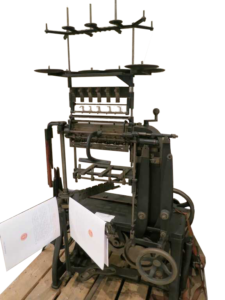 Throughout the 19th century, as bookbinding processes yielded to mechanization, one stubbornly did not: the sewing of mass-produced books was done by hand well into the 1880s. That changed with the introduction of the Smyth #3 Booksewing Machine, the first commercially viable production sewing machine. In the hands of a trained operator the #3 could sew 3000 signatures in an hour; in practical terms, one #3 could replace 15 booksewers on the factory floor.
Throughout the 19th century, as bookbinding processes yielded to mechanization, one stubbornly did not: the sewing of mass-produced books was done by hand well into the 1880s. That changed with the introduction of the Smyth #3 Booksewing Machine, the first commercially viable production sewing machine. In the hands of a trained operator the #3 could sew 3000 signatures in an hour; in practical terms, one #3 could replace 15 booksewers on the factory floor.
The operator would place each signature on one of the rotating arms; the arm pivoted and rose up to where curved needles made stitches that interlocked with those in the previous signature. Within ten years, the publishing industry had been almost completely transformed by the Smyth and its imitators. The name of the inventor, David McConnell Smyth, became synonymous with machine-sewn books–even today they’re referred to as “Smyth sewn.” This is one of only four Smyth #3s we know of that are still in existence.

